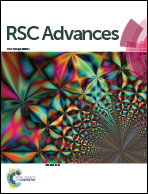Transformation of the coordination nanostructures of 4,4′,4′′-(1,3,5-triazine-2,4,6-triyl) tribenzoic acid molecules on HOPG triggered by the change in the concentration of metal ions†
Abstract
The modulation effects of Cu2+/Fe3+ ions on the hydrogen-bonded structure of 4,4′,4′′-(1,3,5-triazine-2,4,6-triyl) tribenzoic acid (TATB) on a HOPG surface have been investigated at the liquid–solid interface by scanning tunneling microscopy (STM). STM observations directly demonstrated that the self-assembled honeycomb network of TATB has been dramatically transformed after introducing CuCl2/FeCl3 with different concentrations. The metal–organic coordination structures are formed due to the incorporation of the Cu2+/Fe3+ ions. Interestingly, a Cu2+ ion remains coordinated to two COOH groups and only the number of COOH groups involved in coordination doubles when the concentration of Cu2+ ions doubled. A Fe3+ ion changes from coordination to three COOH groups to two COOH groups after increasing the concentration of Fe3+ ions in a mixed solution. Such results suggest that the self-assembled structures of TATB molecules formed by metal–ligand coordination bonds can be effectively adjusted by regulating the concentration of metal ions in a mixed solution, which has rarely been reported before. It explains that the regulatory effect of concentration leads to the diversity of molecular architectures dominated by coordination bonds.



 Please wait while we load your content...
Please wait while we load your content...